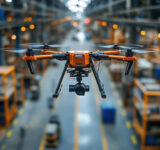Edge-intelligent cities are supported by Edge AI and Agentic AI, writes Dr. Hoe Seng Ooi, CTO at NexAIoT, NEXCOM
Imagine a city where traffic lights self-optimise to clear emergency routes, buildings adapt energy use based on occupancy, and drones monitor infrastructure to prevent failures.
This isn’t a distant future. It’s the emerging reality of smart cities embedded with invisible intelligence.
But while the spotlight often shines on applications like autonomous transit or pollution monitoring, one foundational layer gets overlooked: the computing infrastructure that powers it all.
Cloud computing alone can’t keep pace. Latency delays, overloaded networks, and the risks of transmitting sensitive data offsite are real constraints in environments that demand split-second decisions and airtight privacy.
Intelligence can’t live solely in distant Cloud servers. It needs to be embedded into the edge of the city itself.
How Edge AI is making smart cities possible
Smart cities promise a bold reimagining of urban life, but they also introduce a host of logistical, environmental, and architectural challenges.
Dense populations, aging infrastructure, and the constant flux of people, services, and data make cities uniquely complex environments in which to deploy cutting-edge technology.
That complexity is only magnified at the Edge. Rugged, fast-moving urban systems require local, resilient, and context-aware systems that can process and act on data directly at the source.
To function reliably in these settings, Edge deployments must account for a few core challenges:
- Space constraints: urban real estate is limited, expensive, and highly contested. There’s simply not room for bulky data centres at every transit hub or busy intersection. Edge hardware must be compact, unobtrusive, and easy to integrate into existing infrastructure
- Power and cooling: high-performance systems require consistent power and effective thermal management, but many deployment sites lack the capacity to support either
- Lifecycle management: cities may deploy and maintain thousands of distributed edge devices across complex networks. That demands robust provisioning, remote updates, coordinated maintenance, and secure decommissioning at scale
- Physical security: Edge systems are often located in public, exposed environments, making them vulnerable to tampering, vandalism, or theft. Ruggedised enclosures, intrusion detection, and automated alerts are essential for protecting these assets
Meeting all these requirements calls for Edge infrastructure that’s intelligent enough to process data locally, infer meaning in context, and act with minimal human intervention. That’s where agentic AI can be a gamechanger.
Unlike traditional automation or even conventional AI, agentic AI systems go beyond passive data processing. They pursue goals — interpreting intent, adapting to changing conditions, and executing complex sequences with autonomy.
Consider utilities and infrastructure: agentic AI systems can detect anomalies, assess severity, determine the necessary response, and autonomously initiate service requests or reconfigure local operations — reducing downtime and extending asset life without relying on centralised approval.
Four requirements for building an Edge-intelligent city
Building smart cities powered by Edge AI requires more than deploying sensors. It demands an end-to-end transformation of the urban technology stack.
Here are four foundational components necessary to build an Edge-intelligent urban network:
- Robust connectivity
Without fast, reliable data movement, Edge devices can’t communicate, coordinate, or respond in real time. A hybrid mix of 5G, fibre optics, and resilient mesh networks is essential to maintain performance and ensure continuity across diverse, ever-changing urban conditions.
Take energy management, for example. With agentic AI operating across a distributed smart grid, systems can anticipate demand surges, autonomously rebalance loads, and optimise the use of renewable energy without waiting for centralised input. The result is a more adaptive, sustainable, and resilient grid.
- Distributed compute & storage
Pushing all data to the Cloud introduces latency, risks, and bottlenecks that cities can’t afford. To keep up with real-time demands, cities will need to deploy Edge servers, micro data centres, and intelligent gateways that enable AI inference and storage directly at the source.
This distributed architecture is what makes AI digital twins possible. These real-time, data-driven replicas of city systems — buildings, utilities, transit networks — give planners the ability to simulate scenarios, optimise performance, and anticipate failures before they happen. But for digital twins to be truly effective, they need constant streams of precise, context-aware data that only distributed Edge systems can deliver.
- Centralised orchestration
As Edge nodes multiply, so does complexity. Cities need centralised platforms to provision, monitor, and update thousands of distributed systems.
This interconnected foundation enables innovations like Urban Operating Systems, unified platforms that integrate AI, IoT, and sensor fusion to act as a city’s real-time nervous system. In emergency response, agentic AI embedded at the Edge and orchestrated centrally can synthesise sensor inputs, evaluate threat levels, and deploy resources across fire, police, and medical departments to reduce response times in situations when every second counts.
- Security-first design
Smart cities run on data, which means that privacy, cybersecurity, and ethical considerations must be foundational and integrated into architecture from day one.
Security-first infrastructure starts with robust Edge protections like end-to-end encryption, secure boot processes, tamper detection, continuous threat monitoring, and strict access controls. It also demands responsible data governance, including clear privacy protocols, alignment with national and international regulations, and a commitment to transparency with the public.
Federated learning can play a key role in meeting these goals. By enabling AI models to be trained locally on Edge devices — without moving raw data offsite — cities can reduce exposure while maintaining the intelligence needed to power citywide systems.
Building from the Edge in
As agentic AI continues to evolve, cities are becoming more predictive, personalised, and efficient — capable of making complex decisions in real time and adapting dynamically to changing conditions.
This marks the rise of a new kind of urban intelligence, where computing is seamlessly woven into streets, structures, and systems to meet citizen needs with real-time precision.
By shifting their compute power closer to where the action happens, cities can better anticipate, decide, and evolve at the Edge — delivering a level of autonomy and intelligence that scales with the complexity of urban life.

Dr. Ooi is Chief Technology Officer at NexAIoT, a subsidiary of NEXCOM, where he leads the development of AI technologies, including intelligent AI controllers for robotics and automation systems, AI-based Visual SLAM and navigation for autonomous mobile robots (AMR), AI robot vision, and other IoT solutions that help industrial clients realise the vision of Industry 4.0.
There’s plenty of other editorial on our sister site, Electronic Specifier! Or you can always join in the conversation by visiting our LinkedIn page.










